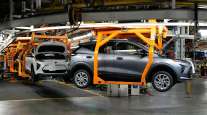Editorial: Phase 2 Taking Hold
This Editorial appears in the Aug. 22 print edition of Transport Topics. Click here to subscribe today.
Updating the adage that the pen is mightier than the sword, we note that a PDF available online will come to shape truck and trailer manufacturing through the late 2020s, namely, the final version of Phase 2 of the federal greenhouse-gas rule.
Other than possibly the authors at the Environmental Protection Agency and the National Highway Traffic Safety Administration, no one yet has a comprehensive understanding of this massive rule — more than 4,000 pages in rule and support documents. Executives, analysts and reporters will be poring over this for weeks and months to come.
We can say that EPA and NHTSA appear to have made a great effort to learn about truck and trailer making. EPA Administrator Gina McCarthy and Transportation Secretary Anthony Foxx said their staffs waded through more than 200,000 public comments and held more than 400 meetings with interested parties.
Many of the nation’s largest truck and trailer makers offered positive comments about the rule, which will mainly be rolled out in several stages over the next decade.
The rule breaks out both costs and benefits: 1.1 billion metric tons of carbon dioxide not emitted over a multiyear period, 2 billion gallons of crude oil not used and $170 billion not spent on fuel.
The nation as a whole will benefit from that, but truck operators will have to foot the bill, about $12,300 extra for a tractor by 2027, $1,090 more for a trailer and $2,680 more for a vocational truck — all in the same time span.
We hope those estimates are not gross underestimations. It’s good to hear that manufacturers are supportive, but the ultimate test is how this new equipment actually handles on the road.
The trucks and trailers need to be durable, capable of working in tough conditions and not so expensive that a carrier can’t make money by using them for providing freight-hauling services.
EPA officials have said they saw what happened in years before and after Jan. 1, 2007, an important change in emissions standards. The pre-buy boom before and the blow-out afterward hurt employment and delayed introduction of the pollution controls on the engines, as truck buyers avoided the vehicles in large numbers. As with nearly everyone in trucking, EPA doesn’t want to repeat that.
We urge both government and industry to monitor events closely, both on the march toward implementation and the actual results from using these vehicles when they’re out. Taking good news for granted hardly ever works out well.




